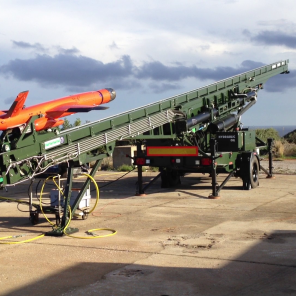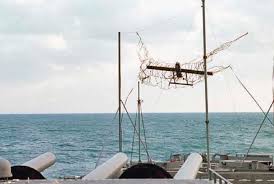Contributed by Amit Lal

We know that Drones are Unmanned Aerial Vehicles so they have an obvious work of getting airborne for carrying out the task they are supposed to perform. There are many methods to assist in these drones getting airborne and then there are systems to track them when they are airborne and then there are systems to help the drones land and be retrieved.
In this article we are going through the details of various such Launch , Track and Retrieve systems that are used commonly.
Launch Methods
Hand Launch : Most light weight drones particularly fixed wing drones and some multirotors are usually hand launched. It is easy for a trained personnel to hand launch but may not be as easy for someone without training. It possesses the risk of propellers hitting the launch personnel and even the drone may get unbalanced if force is applied unevenly. It is helpful in places where a dedicated landing patch is not available.
Pneumatic Catapult Launch : Pneumatic catapult launchers use compressed air or other gases to accelerate a launching cradle along the launcher. A compressor is needed to pressurize the gas, requiring a power supply and potentially being bulky and difficult to transport. It is a common method mostly for decoy drones that can be remotely launched within a short span of time. The method is somehow costly and needs experts to handle them.
Hydraulic Catapult Launch : Hydraulic UAV catapults use a two-compartment cylinder containing oil and compressible gas separated by a piston. Pumping the oil causes the piston to compress the case, which stores energy for launching the UAV. Like pneumatic UAV catapults, hydraulic UAV launchers also require a power supply to operate. This is again not a very cost effective way and also requires expertise to handle.
Bungee Powered Catapult Launch: Bungee-powered UAV catapults are simpler than hydraulic or pneumatic launchers, using energy stored in elastic cords. The cord may be stretched manually or by means of an electric motor. Although they are the quietest and cheapest solution, they are limited to smaller UAVs. This is a simpler method and doesn't require much expertise. This method is also a cheaper method.
Vehicle Launch Cradle: If a surface is available that is unsuitable for the smaller, more delicate landing wheels of a UAV (due to long grass, gravel, unevenness or other obstructions), but sufficient for a larger, more durable vehicle such as a truck to be driven along it, a launch may be possible from that vehicle. The UAV is typically held in a fixed cradle on top of the truck, angled upwards at an angle that gives maximum lift. When the truck has been accelerated to takeoff speed, the cradle is released and the UAV lifts directly upwards into flight. UAVs may also be launched from the deck of a ship using catapult launchers, or from larger aircraft in flight.
Surface Vertical Take Off : This is the most generic take off method only applicable for multirotors and hybrid VTOL drones. A launch pad is placed on the surface and then the drone is kept on the launch pad prevents it from moisture, vegetation, dust from the ground and then the take off is initiated.
Track Methods
GPS Track: It's the best and most common way to track drones. Pretty much like we see our location in Google maps. The GPS unit on the drone gives the latitudinal and longitudinal position of the drone and this data is received by various methods for estimation of the drones position.
Beacon Track : In this method there are various beacons or control points allocated throughout the area and then the drones position is estimated as per the difference between various beacons by triangulation. This method is generally used in places where GPS cannot be used or where other interference occur.
Inertial Track Method : In inertial track method the estimated location of the drone is calculated by values of various sensors such as inertial measurement unit, accelerometer, etc and the change in the inertia of the body. It is a complex method and is used only for very complex drones where very accurate and fast tracking is required.
Retrieving Methods
Parachute Retrieving Method : Parachute systems are a common recovery solution for UAVs, assuming sufficient space and carrying capacity to contain the packed parachute and deployment mechanism. Drone parachutes need to deploy to a sufficient distance so that they do not get entangled, especially on multicopters which may tumble on rotor failure due to inherent instability.
Drone parachute systems can be automated or pilot-triggered. Automated parachute systems need to detect the conditions required for deployment quickly and then trigger rapidly, especially those intended for flight over people. They will typically monitor for conditions such as freefall acceleration as well as low voltage
Net Catch Retrieving Method: Other methods of recovering drones include net systems suspended between poles and attached to a system of purchase lines and shock absorbers. These are simple but risk damaging the UAV due to sudden deceleration. They are also unsuitable for UAVs with unshrouded propellers, as entanglement of the net may lead to damage of the net or to the propellers and engine of the aircraft.
Airbag Retrieving Method : To minimise the effect of impact with the ground or a body of water, UAVs may also be fitted with inflatable airbags or crushable “crumple zone” structures.
Trip Wire Retrieving Method : This method is done only on fixed wing drones and most evident in the Zipline drones where the drone has a hook and when it arrives at the retrieving zone a trip wire is activated that latches to the hook of the drone and stops it .
These are the most common Launching, Tracking and Retrieving methods of drones.




























































Comments